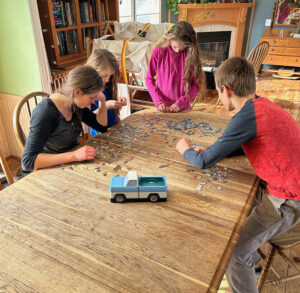
“You’re Amish!”
I glanced back to see where the words came from. The kid was staring straight at me.
“No, I’m not,” I replied.
I had just taken my seat on the bus the first day of attending a new school. Twelve years old, and going into the seventh grade, this was a day I had been dreading. It was not easy to be around new people. Now this.
The kid who spoke appeared to be a couple years older than me, and kept staring accusingly. He wasn’t backing down.
“Yes, you are Amish!”
He was louder this time—with a frown on his face.
“I saw your Mom.”
By now the rest of the kids on the bus were listening and staring too.
“We’re not Amish,” I repeated, “We’re Mennonites.” And at that moment, I wished for all the world that we were neither.

Our family had recently moved to Wayne County, Ohio, from Elida, Ohio, a small town about 140 miles west. Dad had been called into the ministry at the Salem Mennonite Church (Wooster), and this was my first experience riding a public school bus. It was bad enough that my stomach was tied in knots before climbing onto the bus. Now, it was even worse. I would have given anything be back at the tiny Elida Mennonite Christian Day School, with cousins and friends, nearly all of us from the same church, Pike Mennonite.
As for the boy who thought I was Amish—this was a typical misunderstanding for those who are unfamiliar with the many levels of Mennonites and Amish. They think we all dress alike, and if we look sort of like Amish, we must be Amish. Not so. There are many variations in both denominations.

And then, the games we play. Our favorite is the “Mennonite Game.” Certain players have an edge over others—inherited advantages imparted at birth. For those who have never heard of the game, or who would love play it, allow me to explain.
Living in Wayne County, in a Mennonite and Amish community like we do, it is more fun to play the game if you have a local Germanic surname like Miller, Yoder, Amstutz, Lehman, Neuenschwander, or Nussbaum.
For example, this might be a typical introduction. (Keep in mind that Roth is a common name among the Mennonites.)
“Hello, I’m Dan Miller”
“Hi Dan, my name is Dave Ross.”
“Dave Roth. Are you related to the Roths at…..”
“No… it’s Ross, not Roth.”
“Oh, ……….Ross?”
“Yes. Ross.”
And then after a moment of embarrassed silence, I interject that “I married into this community. I’m married to a Neuenschwander.”
Now we’re off and running. Suddenly we can make all kinds of connections.

And that describes the game. It’s not really a game at all. It’s all about making family connections. That seems to be important to us. But that’s partly human nature too. We all have this need to belong to some group or entity, and to feel like we are part of the herd.
I once made the mistake of telling a local gentleman that his last name didn’t sound like a Mennonite name. A ridiculous thing for me to say. I was quickly informed that his last name is common among Mennonites in certain parts of Pennsylvania, and was then reminded that my name was not at all common in Mennonite circles.
This is true. Near as we know, my Great-Grandparents, David and Julia Ross, were part of the United Brethren denomination. They were from Virginia, where David had served as a blacksmith for the Confederate Army during the Civil War. When he died at the young age of forty-seven, Julia and the children moved to Elida, Ohio to be near her oldest son George who had become a Mennonite. Here, she too joined the Mennonite Church. And that was the beginning of the Ross name in Mennonite circles. It’s not difficult to play the “game” on Mom’s side, as her family roots go back almost to the beginnings of the Mennonite denomination, just like most of our Amish neighbors.
And speaking of the Amish: This is where the “Mennonite Game” should be labeled as:

“For ages three to six.” Seriously. The Amish take this game to an entirely new level. It seems the Amish have a fairly limited selection of first names and a short list of last names. In 1920, there were about 5,000 Amish in the USA. Today, their numbers are reported as nearly 300,000. There are a huge number of name duplications. Many have nicknames—even multiple nicknames—to help identify which Mary or Dan or John we are referring to. I used to associate with an Amish fellow whose nickname was Coon-Dan’s-Crist’s-Dan Yoder. Just Dan to me, but if I wanted to explain to someone else which Dan Yoder, I’d need to say the whole string.
For other examples, here is a short list of Amish “who’s who” from around the Kidron area. Happy Dan, Ear Dan, Hammer Dan, Hog Back John, Long John, Buck Wayne, and Buck Wayne’s Mary. Most nicknames describe a person’s location, occupation, a physical characteristic, or a spouse. Happy Dan is always smiling. Hammer Dan is a carpenter. Hogback John lived on Hogback Road. Long John was very tall. And so on.
Interestingly, I’ve learned that there are other groups who have a similar game. My son-in-law attended Calvin College, and says this: “It was an eye opener for me when I got to Calvin and learned that the Christian Reformed do the exact same thing–only it’s called ‘Dutch Bingo’.”
So where can you buy the Mennonite Game? You can’t. But it’s likely you already have your own version.
From our lovely little hometown of Kidron, Ohio, where strangers become friends, and friends become family. Have a wonderful day!

































